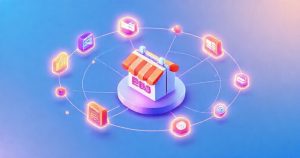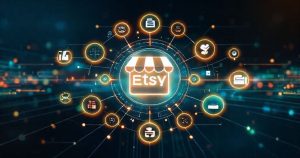In the vibrant world of online marketplaces, Etsy stands out as a unique platform for sellers of handmade goods, vintage items, and craft supplies. As an Etsy shop grows, managing daily operations can become increasingly complex. This is where strategic Etsy integrations become invaluable. These powerful tools connect your Etsy store with other essential business applications, automating tasks and streamlining workflows to enhance efficiency and profitability for sellers worldwide.
Understanding Etsy Integrations: A Foundational Overview
Etsy integrations refer to third-party software or services that connect directly with your Etsy shop. These connections allow data to flow seamlessly between platforms, eliminating manual data entry and reducing errors. For sellers looking to scale their operations, these integrations are not just convenient; they are often essential for maintaining a competitive edge and managing a diverse product catalog efficiently. Effective integration helps consolidate various aspects of your business into a cohesive system.
1. Inventory Management Integrations: Synchronizing Stock Levels
Maintaining accurate inventory across multiple sales channels is a critical challenge for many Etsy sellers. Inventory management integrations automatically update stock levels in real-time, preventing overselling and ensuring customers only purchase available items. These tools are particularly beneficial for shops selling custom jewelry, handmade apparel, or unique art pieces, where each item might be one-of-a-kind or produced in small batches, requiring precise tracking of every SKU.
By centralizing inventory data, sellers can gain a comprehensive overview of their product availability, regardless of where the item is listed. This automation saves considerable time and reduces the risk of disappointing customers due to out-of-stock issues. Moreover, these systems can help identify slow-moving products versus best-sellers, informing future purchasing and production decisions for a more optimized product portfolio strategy.
2. Shipping and Fulfillment Integrations: Streamlining Order Dispatch
Efficient shipping is a cornerstone of excellent customer service on Etsy. Shipping integrations automate crucial aspects of the fulfillment process, from generating shipping labels to tracking packages. These tools often integrate directly with major carriers, allowing sellers to compare shipping rates, print labels with a few clicks, and automatically send tracking information to customers, improving the overall post-purchase experience significantly.
For sellers dealing with a high volume of orders, such as those selling personalized gifts or digital prints that require physical delivery, shipping integrations dramatically cut down on manual processing time. This efficiency can lead to faster dispatch times and reduced operational costs. The ability to monitor all shipments from a single dashboard provides peace of mind and allows for proactive communication with buyers regarding their order status.
3. Accounting and Bookkeeping Integrations: Simplifying Financial Oversight
Managing the financial health of an Etsy business can be daunting, but accounting integrations simplify the process considerably. These tools connect your Etsy sales data directly to popular accounting software, automating the recording of income, expenses, and taxes. This direct data flow ensures accuracy and provides up-to-date financial insights, which are crucial for strategic planning and compliance.
Sellers of all sizes benefit from clear financial reporting, whether they’re tracking sales of intricate craft supplies or custom home decor. By automating bookkeeping, sellers can spend less time on manual data entry and more time creating and marketing their products. This integration is vital for understanding profitability margins, monitoring cash flow, and preparing for tax season without added stress or the need for extensive manual reconciliation.
4. Marketing and CRM Integrations: Enhancing Customer Engagement
Building a loyal customer base is essential for long-term success on Etsy. Marketing and Customer Relationship Management (CRM) integrations help sellers nurture customer relationships and expand their reach. These tools allow for seamless integration with email marketing platforms, enabling automated follow-up emails, promotional campaigns, and personalized communication based on purchase history or browsing behavior.
For shops specializing in unique art prints or bespoke accessories, targeted marketing campaigns can significantly boost repeat business. CRM integrations provide a centralized view of customer interactions, helping sellers understand preferences and tailor their offerings. This strategic use of customer data supports personalized engagement, fostering stronger connections and encouraging repeat purchases, thereby enhancing overall customer lifetime value.
5. Print-on-Demand (POD) Integrations: Expanding Product Offerings
Print-on-Demand (POD) integrations have revolutionized how many Etsy sellers create and sell custom products without holding physical inventory. These integrations connect your Etsy shop directly with POD suppliers, automating the entire fulfillment process from order placement to shipping. This model is ideal for sellers offering custom apparel, mugs, phone cases, or posters, as it eliminates the need for upfront investment in stock.
The profitability of POD products on Etsy can be significant, as sellers only pay for an item once a customer places an order, minimizing financial risk. This integration allows for rapid expansion of product lines and experimentation with new designs without logistical burdens. It’s a game-changer for artists and designers who wish to monetize their creativity through a wide range of physical products with minimal operational overhead.
6. Choosing the Right Etsy Integration: Key Considerations
Selecting the most suitable Etsy integrations requires careful consideration of your specific business needs and goals. Evaluate potential tools based on their functionality, compatibility with your existing systems, ease of use, and pricing structure. While some tools offer comprehensive solutions for multiple areas like inventory and shipping, others specialize in niche functions such as advanced analytics or specific marketing automation.
Consider the scale of your operations, the types of products you sell, and your budget when making decisions. It is often beneficial to start with integrations that address your most pressing pain points, such as inventory control or shipping efficiency, and then expand as your business evolves. Prioritizing robust support and clear documentation from integration providers will also ensure a smoother setup and ongoing usage.
Strategic Integrations for Sustainable Etsy Growth
Leveraging Etsy integrations is a pivotal step for any seller aiming for sustainable growth and operational excellence. By automating routine tasks and centralizing critical business data, these tools empower sellers to focus more on creativity, product development, and customer engagement. Strategic integration not only enhances efficiency and reduces manual errors but also provides valuable insights for informed decision-making, ultimately leading to a more profitable and manageable Etsy business.






